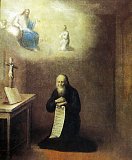

| Previous day | Next day |
| Old Style
April 22
|
Tuesday |
New Style
May 5
|
| 3rd Week after Pascha. Tone 2. | No fast.
|
![]() St. Theodore the Sykeote, bishop of Anastasiopolis (613).
St. Theodore the Sykeote, bishop of Anastasiopolis (613).
Holy Apostle Nathaniel of the Twelve, Apostles Apelles, Luke (not the Evangelist), and Clement, of the Seventy (1st c.). Martyr Epipodius of Lyons (ca. 177). St. Vitalis, monk of the monastery of Abba Seridus at Gaza (609-620). Translation of the relics of St. Vsevolod (in holy baptism Gabriel), prince and wonderworker of Pskov (1834). New Hieromartyr Platon, bishop of Banja Luka (1941). Blessed Fool-for-Christ Ekaterina of Piukhtitsa Convent (Estonia) (1968).
Martyr Leonidas of Alexandria (202). St. Ananias, abbot, of Malles (Crete) (1907).
Repose of Blessed Fool-for-Christ Athanasius Andreyevich Saiko of Orel (1967)
Thoughts for Each Day of the Year
According to the Daily Church Readings from the Word of God
By St. Theophan the Recluse

Tuesday. [Acts 8:5–17; John 6:27–33]
Then Simon himself believed also: and when he was baptized, he continued with Philip (Acts 8:13). He both believed and was baptized, but nothing came of him. One must think that there was something not quite right in the formation of his faith. Sincere faith is the renunciation of your mind. You must bare your mind and present it to faith as a clean slate, so that faith might inscribe itself on the mind as it is, without any mixing in of alien definitions and tenets. When one’s former beliefs remain in the mind, then a mixture occurs in it after the tenets of faith are written there. The consciousness will be confused between the mind’s sophism and the operations of faith. Simon was therefore a model for all heretics, as all who enter the realm of faith thinking as they did as before. They are confused in the faith and nothing comes of them other than harm: for themselves—when they remain silent, for others—when this confusion is not kept within them alone, but breaks out to others, due to their thirst to be teachers. Hence there always turns out to be a party of people more or less sinning in the faith, with a wretched surety of their correctness, and with a calamitous drive to remake everyone their way.
Articles
 Venerable Vitalius of GazaWhen he was sixty years old, undertook an extraordinary task: he wrote down from memory the names of all the prostitutes of Alexandria and he began to pray for them. |
 Blessed Ekaterina of PukhtitsaSt. Ekaterina (Malkov-Panina) was born on May 15, 1889 in Finland in a family with six children. |




